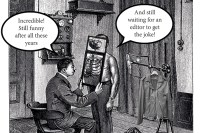Britain’s parliamentary democracy is easily mocked: the medievalisms, the men in tights, the ayes to the right. But it has been preserved because it tends to work. It focuses minds and makes order out of chaos. Yet again we have a general election result that almost no one predicted — and one that offers plenty of lessons for those with an eye to see them.
The communities so often patronised as ‘left behind’, typically in northern and coastal towns, have now demonstrated that they are powerful enough to decide elections. During the Blair and Cameron eras they were written off as a declining demographic: older, poorer, less educated and often stuck in the past. The ‘modernising’ politicians, it was argued, needn’t worry too much about them.
Boris Johnson took a different approach, and it won him his historic majority. Voters in former Labour safe seats are now as important to the Conservatives as suburbia once was to Tony Blair. In an age supposedly dominated by television and digital debate, we have also seen that physical campaigning matters. The Prime Minister went to the places he wanted to win, sometimes several times, and — to his credit — did not stop once the election was over. The day after he won he went back to Sedgefield, Blair’s old seat. The former mayor of London will now need to be a Prime Minister who is dedicated to places far away from the capital and visits them. Donald Trump, for all of his foibles, sets an example in travelling all over America to speak to the people who lent him their support. His campaigning never stops. It’s a trick No. 10 could copy.
The biggest swings to the Tories came in areas with low-skilled workers — which is less of a surprise than it might seem when you recall that wages of the low-paid have risen faster than anyone else’s over the course of this decade. This is due to Tory welfare reform, tax cuts and the jobs boom. Since 2010, progressive Conservatism was aimed at helping those who needed it most. The social justice agenda took time, but it worked, and voters noticed.
This is not a picture anyone would have picked up from social media, now exposed as a hopeless means by which to judge the public mood. Too many in Westminster have been lured into Twitter’s moronic inferno, thinking they are joining a ‘-national conversation’. People who should know better got lost down this digital rabbit hole.
Corbynism was spread digitally, as various left-wing campaigners were able to mobilise, join the Labour party and elect him leader. It will be hard to wrest control of the party away from them while they make up a majority of the membership.
Just as problematic for Labour is the idea that ‘centrist’ — i.e. Blairite — policies are the remedy. It was under Blair that the rot began: he reoriented the party towards middle–class graduates and started the neglect of its traditional voters. There is no point in the Tories trying to perform a kind of inverse Blairism: that is, moving to the left on the economy and to the right on social issues. Left-wing economic policies will not help the north, because they tend not to work anywhere. Pouring money into an un-reformed NHS will not lead to a better health service. The recipe for prosperity is to keep taxes low and regulation light. The Tories forget this at their peril.
We have also seen, yet again, that politicians who break their promises are not forgiven. Nick Clegg learned this with tuition fees in 2015. This election, look to Dominic Grieve and others who in 2017 promised to respect the referendum result before then trying to subvert it. Labour MPs who kept their word personally, such as Caroline Flint, were thrown out because their party threatened a second referendum. Over the past year, rebel MPs have liked to quote Burke, to the effect that an MP’s personal judgment matters more than their constituents’ opinion. They seldom mention that, after making this proclamation, Burke lost his seat.
A big Tory majority does not mean that Corbynism has been crushed. Ten million voted for his far-left agenda — an agenda that won over the prosperous seat of Putney. Too many Tories lazily assumed that socialism died in the 1980s and didn’t need to be killed off again. As Tony Benn observed at the time, no political battle is ever settled conclusively. The same cases need to be made, and won. The Tories have to rediscover the lost art of political argument.
It would be dangerous, too, for the Tories to assume that this was a huge victory for Conservatism. Overall, people voted to end the chaos of a gridlocked parliament,to move on from Brexit and to end the three years of bickering — not to vindicate any set of political beliefs. Now is not the time for Tory triumphalism. Laura Pidcock, the Corbynite MP who famously declared that she could never be friends with a Tory, ended up being replaced by one. Such tribal sectarianism is a turnoff for voters. The tone the Prime Minister has adopted since the election — saying he seeks to serve Remainers as much as he does his new northern voters — is the better approach.
Ever since the 2014 Scottish referendum, British politics has been in turmoil. The country now needs a period of stability and a government more interested in healing divisions than in creating new ones. The Prime Minister stood as a liberal conservative. If he can govern as one, the next decade in British history will be his to shape.





Comments